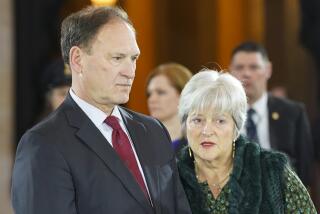Conservatives Cheer Court Nominee
WASHINGTON — Energizing his conservative supporters, President Bush on Monday named Samuel A. Alito Jr., a federal appeals court judge with a 15-year record on the bench, to replace retiring Supreme Court Justice Sandra Day O’Connor.
Alito was immediately embraced by Republicans who had parted company with Bush over the ill-fated nomination of White House Counsel Harriet E. Miers, who withdrew last week after it became clear that her prospects for confirmation were shaky.
“This moves the court to a more conservative tilt, no doubt about it,” said Jay Sekulow, chief counsel for the American Center for Law and Justice, a Christian legal foundation, and a key White House advisor on judicial appointments. “Justice O’Connor was the swing vote on a lot of cases, and she sometimes swung in the other direction.”
But Bush’s choice of a candidate with a more certain conservative philosophy set the stage for a confrontation with Senate Democrats, who fear that Alito will move the high court further to the right on key issues -- particularly abortion rights.
“We need to be careful here,” said Sen. Charles E. Schumer (D-N.Y.), a member of the Judiciary Committee, which screens judicial candidates. “This is a nominee who could shift the balance of the court, and thus the laws of the nation, for decades to come.”
Bush, who introduced Alito during a brief morning ceremony in the White House residential quarters, said he chose the 55-year-old jurist because his record indicated that he shared the president’s view of the “proper role” of federal judges.
“He understands that judges are to interpret the laws, not to impose their preferences or priorities on the people,” Bush said.
Alito, who worked as a Justice Department lawyer and a U.S. attorney before being named to the U.S. 3rd Circuit Court of Appeals in 1990, promised Bush that, if confirmed, he would interpret the Constitution and laws “with care and restraint, always keeping in mind the limited role that the courts play in our constitutional system.”
One antiabortion group, Operation Rescue, predicted that Alito’s confirmation would put the high court “on the fast track to derailing Roe v. Wade as the law of the land,” referring to the landmark 1973 decision that affirmed a woman’s right to choose abortion.
But legal scholars and court observers said it was not clear how Alito might rule if a case that could overturn Roe vs. Wade came before the high court -- or whether a majority of the nine justices would vote to overturn if Alito chose to do so.
At the same time, it appeared to be clear that the addition of Alito would give the high court a more conservative cast than it has had with O’Connor, a centrist who sometimes sided with the court’s liberal justices.
Some legal analysts said that Alito was in the mold of justices Antonin Scalia and Clarence Thomas, who anchor the Supreme Court’s conservative wing. He has even been called “Scalito,” a reference to Alito and Scalia’s Italian American heritage as well as their similar legal philosophies.
But others said they perceived Alito as more akin to Chief Justice John G. Roberts Jr., who was confirmed in late September to replace the late William H. Rehnquist. Roberts is regarded as a consistent conservative, but not as ideological as Scalia or Thomas.
Alito’s nomination represents a sharp course change in the White House political strategy for replacing O’Connor, who announced in July that she planned to retire. Bush’s first choice for the seat was Roberts, but he was moved to become chief justice when Rehnquist died in early September. In nominating Miers, the president chose a close friend and political ally with no judicial experience, wagering that social conservatives and other elements of his political base would trust his judgment. It proved a bad bet.
In naming Alito, White House advisors said, Bush reverted to the same game plan that led to the choice of Roberts: He chose from a short list of experienced jurists who had been blessed in advance by conservative activists and picked the candidate considered most likely to squeak through a divided Senate.
Bush rejected entreaties by conservatives and liberals alike to appoint a woman to replace O’Connor. If Alito is confirmed, Ruth Bader Ginsburg will be the lone female justice.
Among those who had urged the president to pick a woman were his wife, Laura, and O’Connor, the first woman to serve on the court.
“The president always considers a diverse group of potential nominees; he looks at people from all backgrounds and all walks of life,” White House Press Secretary Scott McClellan said Monday.
In the end, however, Alito was “the person who he believes is the best one to fill this vacancy at this time,” McClellan said.
Bush initially interviewed Alito in July about a possible Supreme Court nomination, McClellan said, shortly after O’Connor announced her intention to retire. After Miers withdrew her name from consideration, Bush called Alito on Friday and raised the possibility again.
The decision was settled by the time Bush headed for his Camp David retreat Friday afternoon, McClellan said. Alito met with the president in the Oval Office at 7 a.m. Monday and formally accepted the offer. His wife, Martha-Ann Bomgardner, and children Laura, 17, and Philip, 19, joined them 20 minutes later. The nomination was announced at 8 a.m.
On Capitol Hill, Bush’s decision was roundly praised by Senate Republicans but met with a mixed response from Democrats. Some denounced Alito as an unfit replacement for O’Connor; others said they would reserve judgment until more was known about his judicial record.
California’s two senators, both Democrats, reflected the competing sentiments. Sen. Barbara Boxer said she believed the nomination was “aimed at appeasing the most right-wing elements of the president’s political base,” while Sen. Dianne Feinstein said she hoped “people on both sides would hold their fire, allow the Judiciary Committee to do its work and not take a position until that work is completed.”
Although a contentious confirmation battle seemed certain, it was not clear whether Democrats would be willing to block Alito’s confirmation by using their ability to filibuster or engage in extended debate. Doing so could prompt Republicans to approve a parliamentary rule change barring use of the filibuster in judicial confirmations, a possibility sometimes called the “nuclear option.”
Members of the “Gang of 14,” a bipartisan group of senators whose votes have been pivotal on previous judicial nominations, advised a more cautious approach.
“Judge Alito needs to have a fair and thorough hearing, and we should withhold judgment until that process unfolds,” said Sen. Ben Nelson (D-Neb.), a member of the group, which helped avert a showdown over filibusters this year.
Although Alito’s writings will be thoroughly dissected in the Senate to discern his positions on a range of issues, perhaps no subject will receive closer scrutiny than his limited record on abortion rights.
In one appeals court case, Alito was the lone dissenter in a ruling that struck down a Pennsylvania law requiring married women to notify their husbands before getting an abortion. But his dissenting opinion did not directly address the issues decided in Roe vs. Wade.
Even so, the prospect that Alito might replace O’Connor energized antiabortion groups and rattled abortion rights advocates.
Kate Michelman, who headed NARAL Pro-Choice America from 1985 to 2004, called Alito’s nomination “the greatest threat to women’s fundamental rights and liberties in more than three decades.”
Michelman cited her own experience during the pre-Roe era, when she discovered she was pregnant after her husband abandoned her and their three young children. She applied for and received permission to get a legal “therapeutic” abortion, but only after obtaining her husband’s consent.
“Roe v. Wade emancipated women from the humiliation I endured,” Michelman said. “Judge Samuel Alito voted to return us to it.”
The son of an Italian immigrant, Alito grew up in the suburbs of Trenton, N.J., graduating from Princeton University and Yale Law School. He worked in the U.S. solicitor general’s office during the Reagan administration, arguing 12 cases before the Supreme Court, then became a deputy assistant attorney general in the Justice Department.
In 1987, Reagan appointed Alito as U.S. attorney for New Jersey. Three years later, President George H.W. Bush selected him to sit on the 3rd Circuit Court of Appeals, which is based in Philadelphia. The Senate approved both nominations by unanimous consent, a favorable portent cited Monday by the president and his allies.
During his 15 years on the 3rd Circuit, Alito has participated in thousands of appeals and written hundreds of opinions, providing political friends and foes with plenty of documented evidence of his legal philosophy and judicial temperament.
One of the main criticisms of Miers was that she had no judicial experience, making it difficult to determine how she might interpret the Constitution. In introducing Alito, Bush noted pointedly that he had more judicial experience than any Supreme Court nominee in more than 70 years.
*
Times staff writer Richard Simon contributed to this report.
More to Read
Get the L.A. Times Politics newsletter
Deeply reported insights into legislation, politics and policy from Sacramento, Washington and beyond. In your inbox three times per week.
You may occasionally receive promotional content from the Los Angeles Times.










